Managerial Finance: Evaluating Exchange Rates Using Big Mac Index
VerifiedAdded on 2023/06/08
|12
|2226
|143
Report
AI Summary
This report provides a detailed analysis of the Big Mac Index, a unique economic indicator used to measure purchasing power parity (PPP) between currencies. It begins with an introduction to the index, explaining its origin and purpose as an informal way of assessing currency valuation. The report then outlines the methodology behind the Big Mac Index, using the price of a Big Mac hamburger in different countries as a benchmark for comparing exchange rates. It explains how the index can reveal whether a currency is overvalued or undervalued. The report discusses the underlying assumptions of the PPP theory and the limitations of the Big Mac Index, including factors like product availability, demand, supply, and other economic influences. It also presents an analogy using the iPhone, illustrating the index's imperfections. The report concludes by acknowledging the Big Mac Index as a lighthearted approach to understanding exchange rate differences and its value in providing a different perspective on currency valuation.
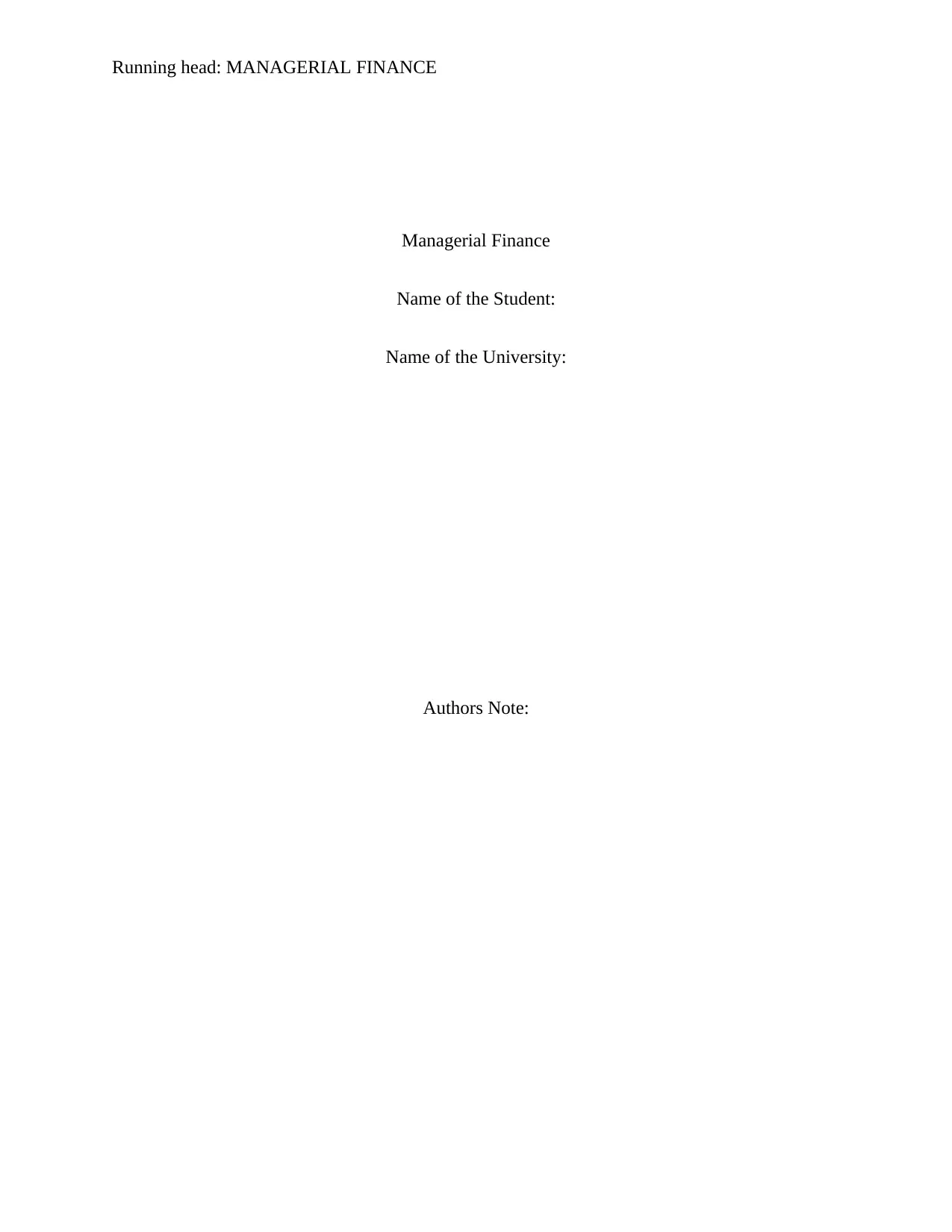
Running head: MANAGERIAL FINANCE
Managerial Finance
Name of the Student:
Name of the University:
Authors Note:
Managerial Finance
Name of the Student:
Name of the University:
Authors Note:
Paraphrase This Document
Need a fresh take? Get an instant paraphrase of this document with our AI Paraphraser
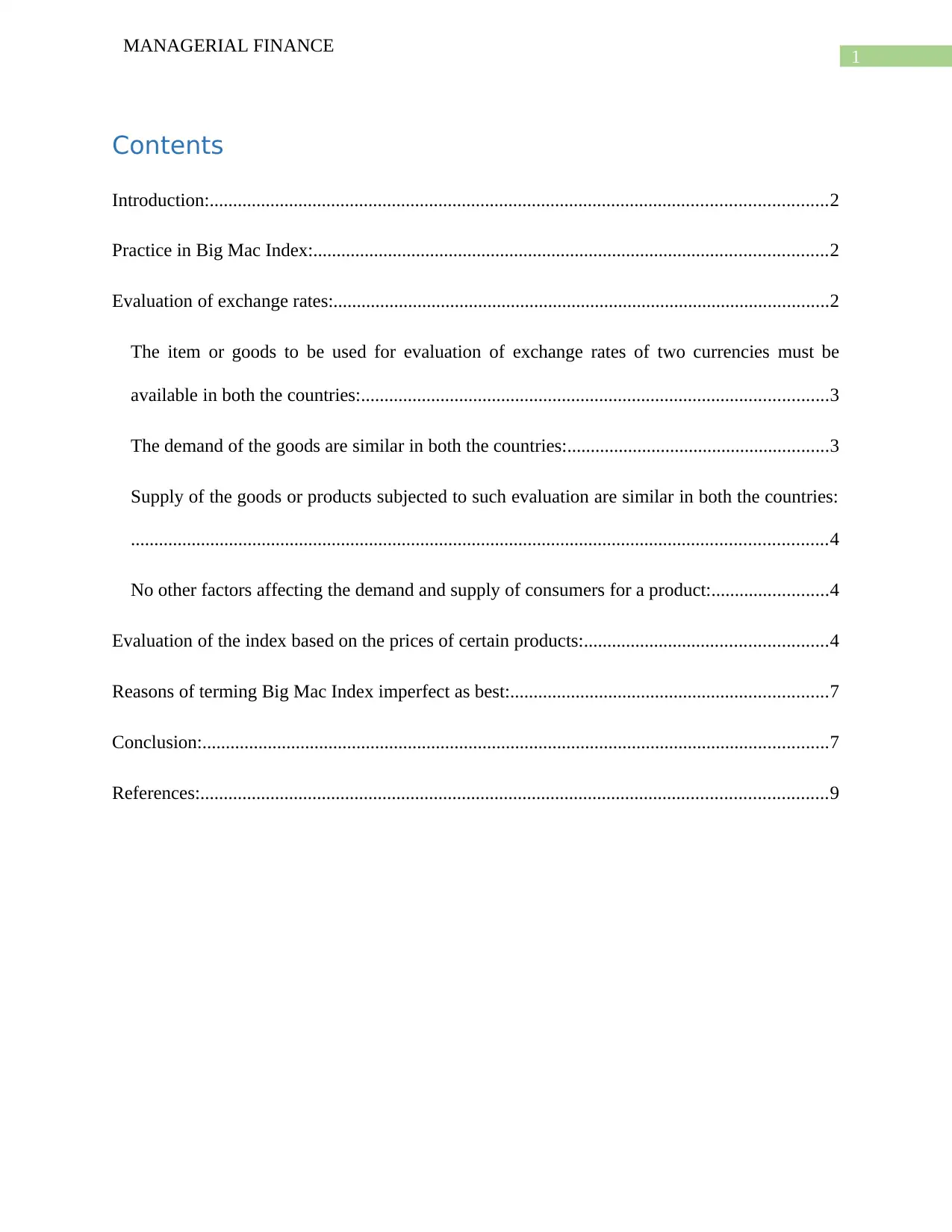
1
MANAGERIAL FINANCE
Contents
Introduction:....................................................................................................................................2
Practice in Big Mac Index:..............................................................................................................2
Evaluation of exchange rates:..........................................................................................................2
The item or goods to be used for evaluation of exchange rates of two currencies must be
available in both the countries:....................................................................................................3
The demand of the goods are similar in both the countries:........................................................3
Supply of the goods or products subjected to such evaluation are similar in both the countries:
.....................................................................................................................................................4
No other factors affecting the demand and supply of consumers for a product:.........................4
Evaluation of the index based on the prices of certain products:....................................................4
Reasons of terming Big Mac Index imperfect as best:....................................................................7
Conclusion:......................................................................................................................................7
References:......................................................................................................................................9
MANAGERIAL FINANCE
Contents
Introduction:....................................................................................................................................2
Practice in Big Mac Index:..............................................................................................................2
Evaluation of exchange rates:..........................................................................................................2
The item or goods to be used for evaluation of exchange rates of two currencies must be
available in both the countries:....................................................................................................3
The demand of the goods are similar in both the countries:........................................................3
Supply of the goods or products subjected to such evaluation are similar in both the countries:
.....................................................................................................................................................4
No other factors affecting the demand and supply of consumers for a product:.........................4
Evaluation of the index based on the prices of certain products:....................................................4
Reasons of terming Big Mac Index imperfect as best:....................................................................7
Conclusion:......................................................................................................................................7
References:......................................................................................................................................9
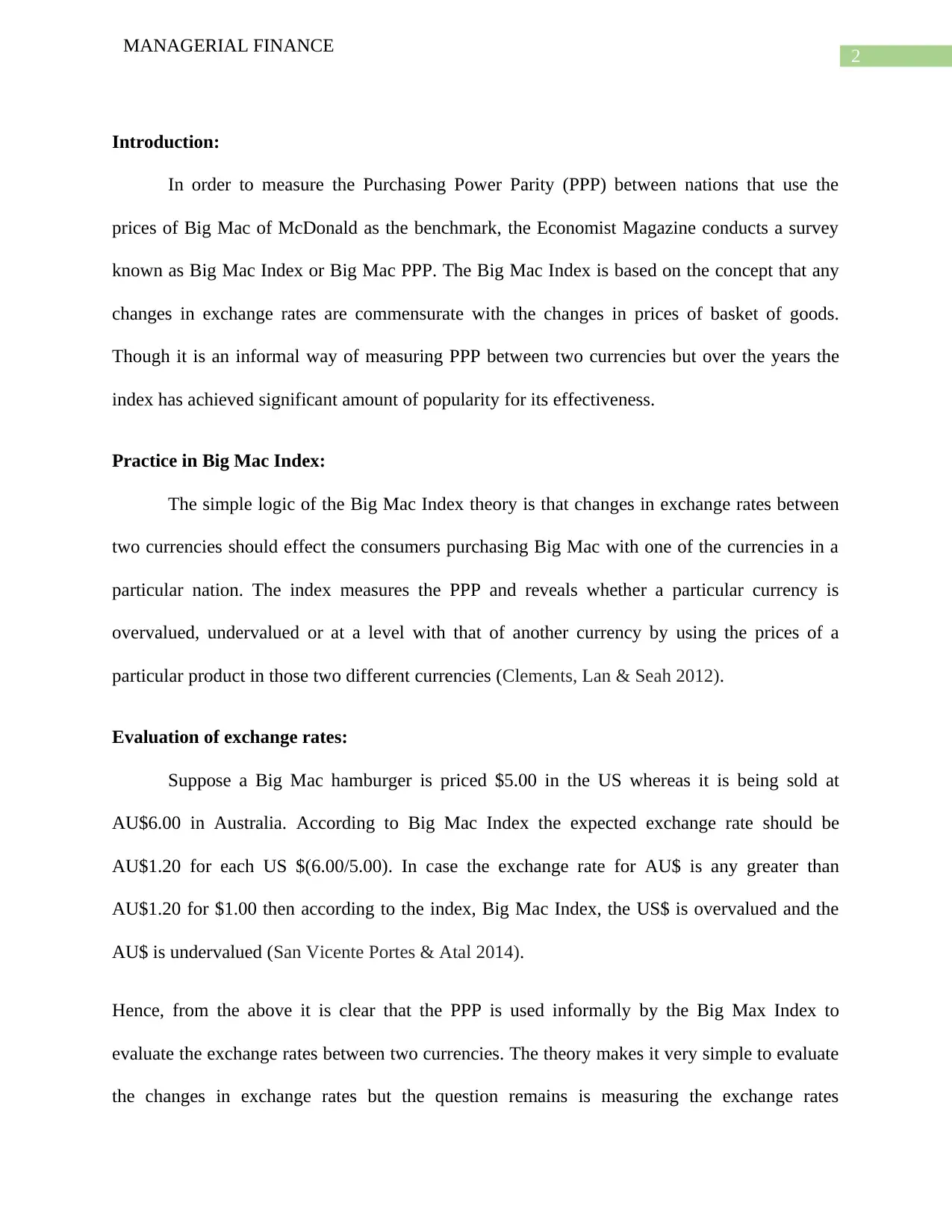
2
MANAGERIAL FINANCE
Introduction:
In order to measure the Purchasing Power Parity (PPP) between nations that use the
prices of Big Mac of McDonald as the benchmark, the Economist Magazine conducts a survey
known as Big Mac Index or Big Mac PPP. The Big Mac Index is based on the concept that any
changes in exchange rates are commensurate with the changes in prices of basket of goods.
Though it is an informal way of measuring PPP between two currencies but over the years the
index has achieved significant amount of popularity for its effectiveness.
Practice in Big Mac Index:
The simple logic of the Big Mac Index theory is that changes in exchange rates between
two currencies should effect the consumers purchasing Big Mac with one of the currencies in a
particular nation. The index measures the PPP and reveals whether a particular currency is
overvalued, undervalued or at a level with that of another currency by using the prices of a
particular product in those two different currencies (Clements, Lan & Seah 2012).
Evaluation of exchange rates:
Suppose a Big Mac hamburger is priced $5.00 in the US whereas it is being sold at
AU$6.00 in Australia. According to Big Mac Index the expected exchange rate should be
AU$1.20 for each US $(6.00/5.00). In case the exchange rate for AU$ is any greater than
AU$1.20 for $1.00 then according to the index, Big Mac Index, the US$ is overvalued and the
AU$ is undervalued (San Vicente Portes & Atal 2014).
Hence, from the above it is clear that the PPP is used informally by the Big Max Index to
evaluate the exchange rates between two currencies. The theory makes it very simple to evaluate
the changes in exchange rates but the question remains is measuring the exchange rates
MANAGERIAL FINANCE
Introduction:
In order to measure the Purchasing Power Parity (PPP) between nations that use the
prices of Big Mac of McDonald as the benchmark, the Economist Magazine conducts a survey
known as Big Mac Index or Big Mac PPP. The Big Mac Index is based on the concept that any
changes in exchange rates are commensurate with the changes in prices of basket of goods.
Though it is an informal way of measuring PPP between two currencies but over the years the
index has achieved significant amount of popularity for its effectiveness.
Practice in Big Mac Index:
The simple logic of the Big Mac Index theory is that changes in exchange rates between
two currencies should effect the consumers purchasing Big Mac with one of the currencies in a
particular nation. The index measures the PPP and reveals whether a particular currency is
overvalued, undervalued or at a level with that of another currency by using the prices of a
particular product in those two different currencies (Clements, Lan & Seah 2012).
Evaluation of exchange rates:
Suppose a Big Mac hamburger is priced $5.00 in the US whereas it is being sold at
AU$6.00 in Australia. According to Big Mac Index the expected exchange rate should be
AU$1.20 for each US $(6.00/5.00). In case the exchange rate for AU$ is any greater than
AU$1.20 for $1.00 then according to the index, Big Mac Index, the US$ is overvalued and the
AU$ is undervalued (San Vicente Portes & Atal 2014).
Hence, from the above it is clear that the PPP is used informally by the Big Max Index to
evaluate the exchange rates between two currencies. The theory makes it very simple to evaluate
the changes in exchange rates but the question remains is measuring the exchange rates
⊘ This is a preview!⊘
Do you want full access?
Subscribe today to unlock all pages.

Trusted by 1+ million students worldwide
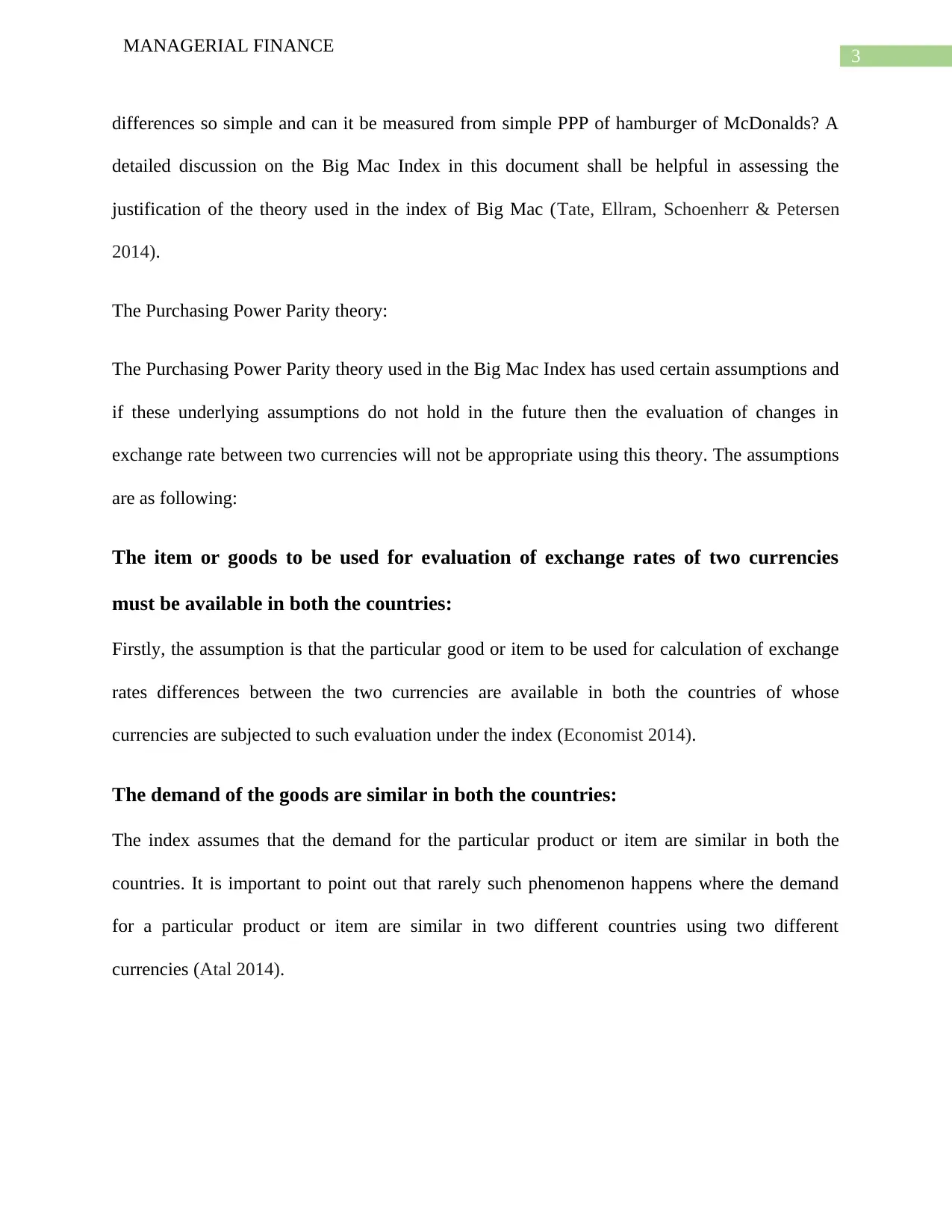
3
MANAGERIAL FINANCE
differences so simple and can it be measured from simple PPP of hamburger of McDonalds? A
detailed discussion on the Big Mac Index in this document shall be helpful in assessing the
justification of the theory used in the index of Big Mac (Tate, Ellram, Schoenherr & Petersen
2014).
The Purchasing Power Parity theory:
The Purchasing Power Parity theory used in the Big Mac Index has used certain assumptions and
if these underlying assumptions do not hold in the future then the evaluation of changes in
exchange rate between two currencies will not be appropriate using this theory. The assumptions
are as following:
The item or goods to be used for evaluation of exchange rates of two currencies
must be available in both the countries:
Firstly, the assumption is that the particular good or item to be used for calculation of exchange
rates differences between the two currencies are available in both the countries of whose
currencies are subjected to such evaluation under the index (Economist 2014).
The demand of the goods are similar in both the countries:
The index assumes that the demand for the particular product or item are similar in both the
countries. It is important to point out that rarely such phenomenon happens where the demand
for a particular product or item are similar in two different countries using two different
currencies (Atal 2014).
MANAGERIAL FINANCE
differences so simple and can it be measured from simple PPP of hamburger of McDonalds? A
detailed discussion on the Big Mac Index in this document shall be helpful in assessing the
justification of the theory used in the index of Big Mac (Tate, Ellram, Schoenherr & Petersen
2014).
The Purchasing Power Parity theory:
The Purchasing Power Parity theory used in the Big Mac Index has used certain assumptions and
if these underlying assumptions do not hold in the future then the evaluation of changes in
exchange rate between two currencies will not be appropriate using this theory. The assumptions
are as following:
The item or goods to be used for evaluation of exchange rates of two currencies
must be available in both the countries:
Firstly, the assumption is that the particular good or item to be used for calculation of exchange
rates differences between the two currencies are available in both the countries of whose
currencies are subjected to such evaluation under the index (Economist 2014).
The demand of the goods are similar in both the countries:
The index assumes that the demand for the particular product or item are similar in both the
countries. It is important to point out that rarely such phenomenon happens where the demand
for a particular product or item are similar in two different countries using two different
currencies (Atal 2014).
Paraphrase This Document
Need a fresh take? Get an instant paraphrase of this document with our AI Paraphraser
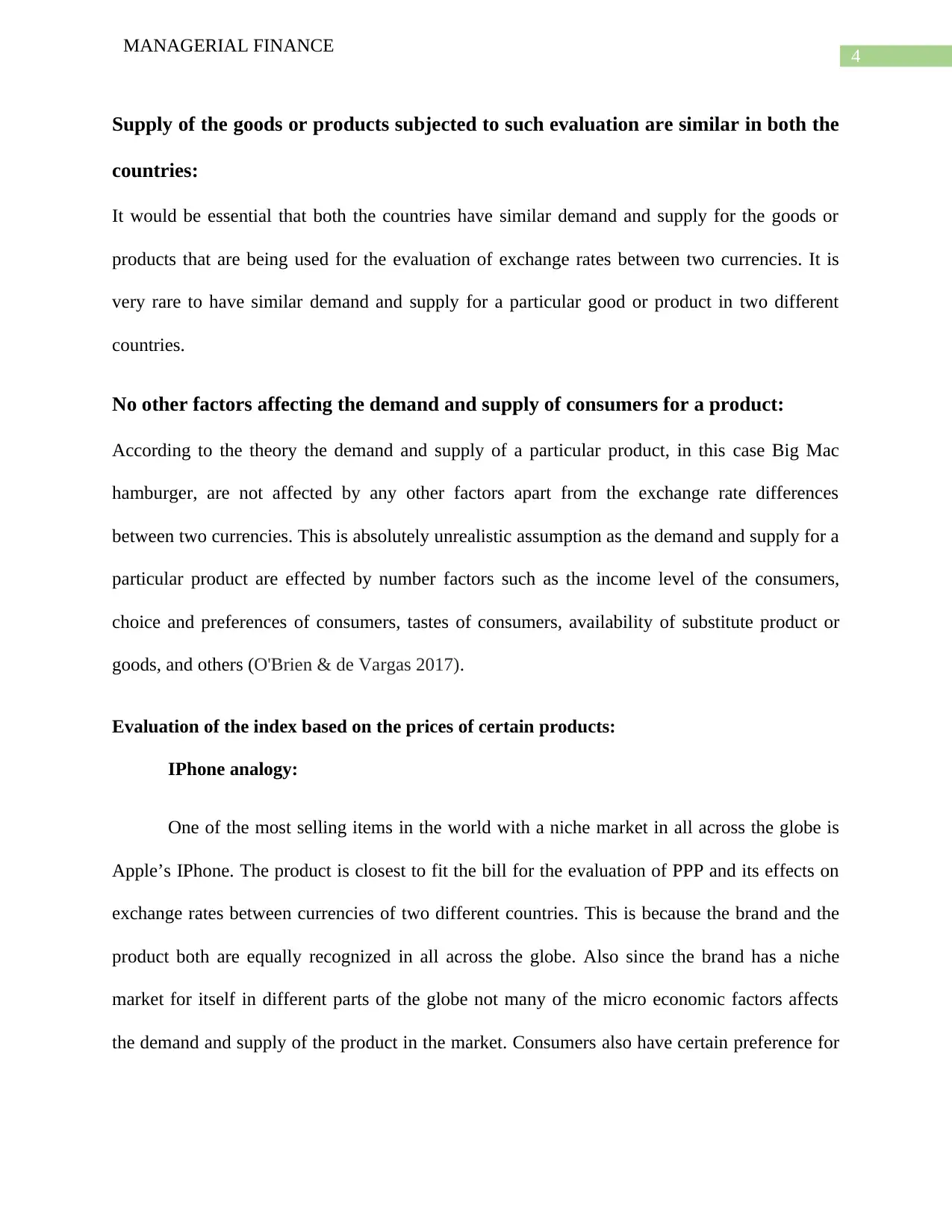
4
MANAGERIAL FINANCE
Supply of the goods or products subjected to such evaluation are similar in both the
countries:
It would be essential that both the countries have similar demand and supply for the goods or
products that are being used for the evaluation of exchange rates between two currencies. It is
very rare to have similar demand and supply for a particular good or product in two different
countries.
No other factors affecting the demand and supply of consumers for a product:
According to the theory the demand and supply of a particular product, in this case Big Mac
hamburger, are not affected by any other factors apart from the exchange rate differences
between two currencies. This is absolutely unrealistic assumption as the demand and supply for a
particular product are effected by number factors such as the income level of the consumers,
choice and preferences of consumers, tastes of consumers, availability of substitute product or
goods, and others (O'Brien & de Vargas 2017).
Evaluation of the index based on the prices of certain products:
IPhone analogy:
One of the most selling items in the world with a niche market in all across the globe is
Apple’s IPhone. The product is closest to fit the bill for the evaluation of PPP and its effects on
exchange rates between currencies of two different countries. This is because the brand and the
product both are equally recognized in all across the globe. Also since the brand has a niche
market for itself in different parts of the globe not many of the micro economic factors affects
the demand and supply of the product in the market. Consumers also have certain preference for
MANAGERIAL FINANCE
Supply of the goods or products subjected to such evaluation are similar in both the
countries:
It would be essential that both the countries have similar demand and supply for the goods or
products that are being used for the evaluation of exchange rates between two currencies. It is
very rare to have similar demand and supply for a particular good or product in two different
countries.
No other factors affecting the demand and supply of consumers for a product:
According to the theory the demand and supply of a particular product, in this case Big Mac
hamburger, are not affected by any other factors apart from the exchange rate differences
between two currencies. This is absolutely unrealistic assumption as the demand and supply for a
particular product are effected by number factors such as the income level of the consumers,
choice and preferences of consumers, tastes of consumers, availability of substitute product or
goods, and others (O'Brien & de Vargas 2017).
Evaluation of the index based on the prices of certain products:
IPhone analogy:
One of the most selling items in the world with a niche market in all across the globe is
Apple’s IPhone. The product is closest to fit the bill for the evaluation of PPP and its effects on
exchange rates between currencies of two different countries. This is because the brand and the
product both are equally recognized in all across the globe. Also since the brand has a niche
market for itself in different parts of the globe not many of the micro economic factors affects
the demand and supply of the product in the market. Consumers also have certain preference for

5
MANAGERIAL FINANCE
the item and belongs to a class of consumers where the price of the products generally do not
affect the demand of the product in the market (Clements & Si 2017).
Now the IPhone is priced at a whopping $1000 in the US, IPhone X on the date of its launch, i.e.
on November 3, 2017. The phone was also available at Australia from the date of its launch with
a price tag of AU$1,579. Thus, the prices of IPhone X in two different countries are summarized
in the table below:
Countries USA Australia
IPhone X US$1,000.00 AU$1,579.00
US$ AU$
0
200
400
600
800
1000
1200
1400
1600
1800
`
The two points in X axis shows the prices of IPhone X in US and Australia. Taking into
consideration the above prices it can be calculated that the exchange rate of AU$ with US$
should be AU$1.579 for each US$ (1579/1000). However, on the date of above prices the
exchange rate between the two countries were AU$1.279 for each US$. Thus, the actual
MANAGERIAL FINANCE
the item and belongs to a class of consumers where the price of the products generally do not
affect the demand of the product in the market (Clements & Si 2017).
Now the IPhone is priced at a whopping $1000 in the US, IPhone X on the date of its launch, i.e.
on November 3, 2017. The phone was also available at Australia from the date of its launch with
a price tag of AU$1,579. Thus, the prices of IPhone X in two different countries are summarized
in the table below:
Countries USA Australia
IPhone X US$1,000.00 AU$1,579.00
US$ AU$
0
200
400
600
800
1000
1200
1400
1600
1800
`
The two points in X axis shows the prices of IPhone X in US and Australia. Taking into
consideration the above prices it can be calculated that the exchange rate of AU$ with US$
should be AU$1.579 for each US$ (1579/1000). However, on the date of above prices the
exchange rate between the two countries were AU$1.279 for each US$. Thus, the actual
⊘ This is a preview!⊘
Do you want full access?
Subscribe today to unlock all pages.

Trusted by 1+ million students worldwide
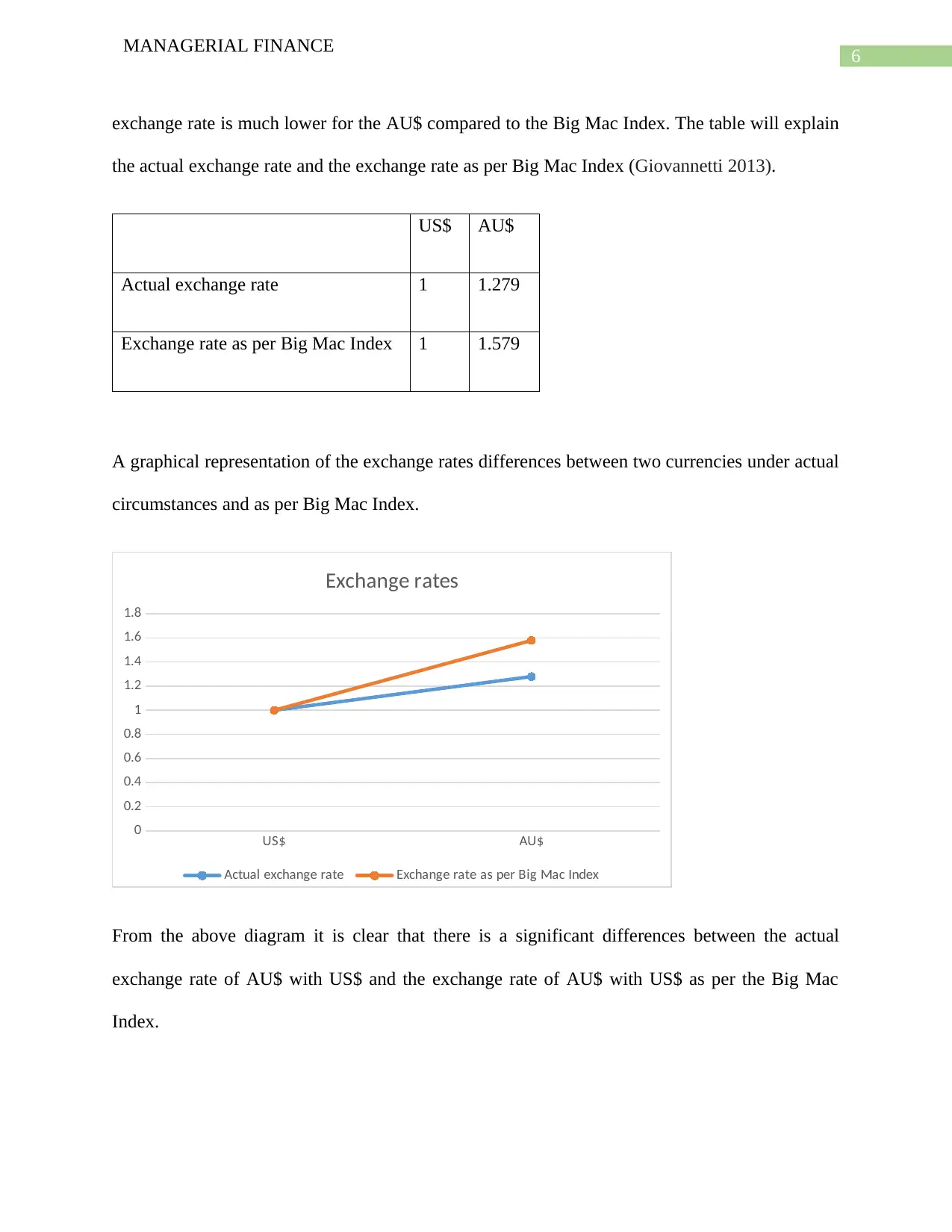
6
MANAGERIAL FINANCE
exchange rate is much lower for the AU$ compared to the Big Mac Index. The table will explain
the actual exchange rate and the exchange rate as per Big Mac Index (Giovannetti 2013).
US$ AU$
Actual exchange rate 1 1.279
Exchange rate as per Big Mac Index 1 1.579
A graphical representation of the exchange rates differences between two currencies under actual
circumstances and as per Big Mac Index.
US$ AU$
0
0.2
0.4
0.6
0.8
1
1.2
1.4
1.6
1.8
Exchange rates
Actual exchange rate Exchange rate as per Big Mac Index
From the above diagram it is clear that there is a significant differences between the actual
exchange rate of AU$ with US$ and the exchange rate of AU$ with US$ as per the Big Mac
Index.
MANAGERIAL FINANCE
exchange rate is much lower for the AU$ compared to the Big Mac Index. The table will explain
the actual exchange rate and the exchange rate as per Big Mac Index (Giovannetti 2013).
US$ AU$
Actual exchange rate 1 1.279
Exchange rate as per Big Mac Index 1 1.579
A graphical representation of the exchange rates differences between two currencies under actual
circumstances and as per Big Mac Index.
US$ AU$
0
0.2
0.4
0.6
0.8
1
1.2
1.4
1.6
1.8
Exchange rates
Actual exchange rate Exchange rate as per Big Mac Index
From the above diagram it is clear that there is a significant differences between the actual
exchange rate of AU$ with US$ and the exchange rate of AU$ with US$ as per the Big Mac
Index.
Paraphrase This Document
Need a fresh take? Get an instant paraphrase of this document with our AI Paraphraser
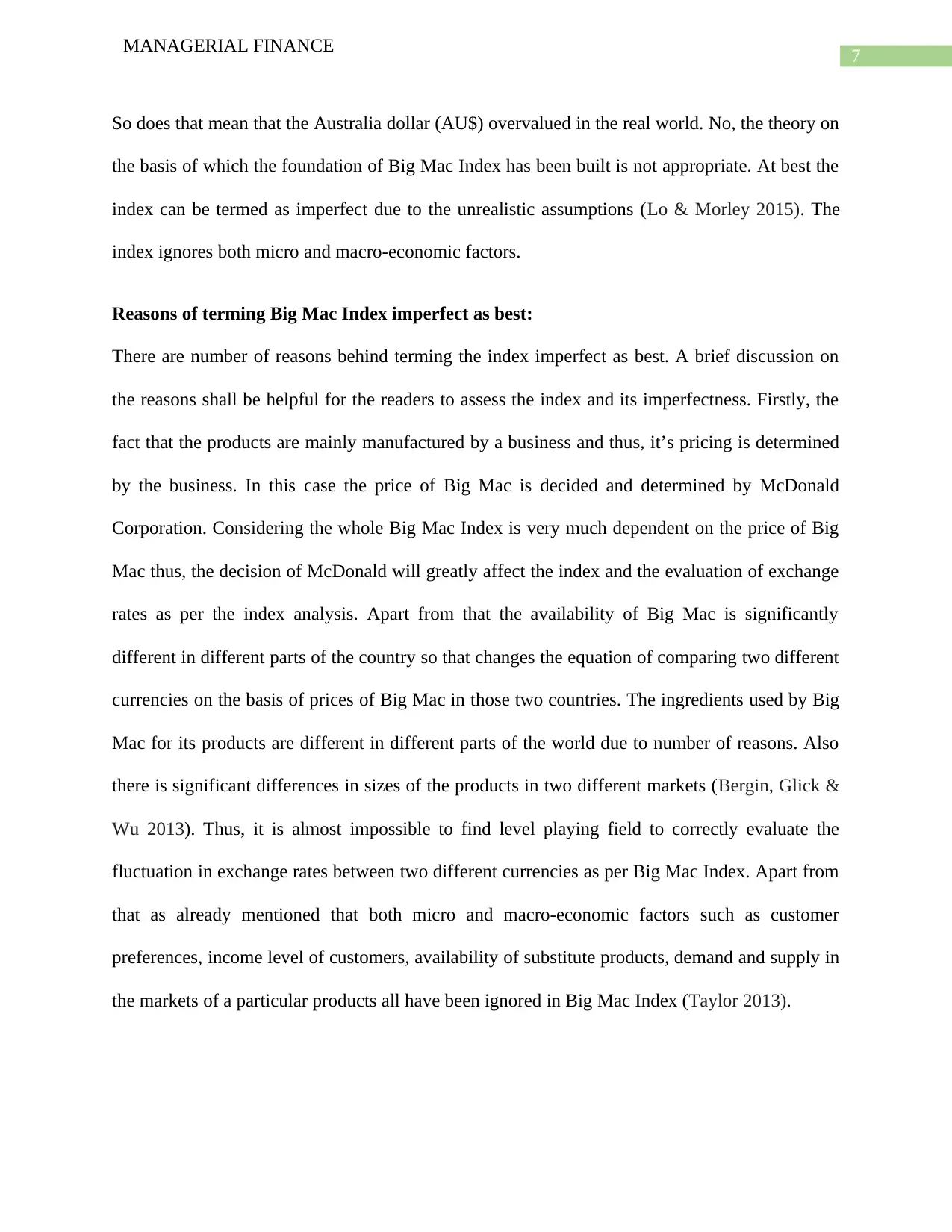
7
MANAGERIAL FINANCE
So does that mean that the Australia dollar (AU$) overvalued in the real world. No, the theory on
the basis of which the foundation of Big Mac Index has been built is not appropriate. At best the
index can be termed as imperfect due to the unrealistic assumptions (Lo & Morley 2015). The
index ignores both micro and macro-economic factors.
Reasons of terming Big Mac Index imperfect as best:
There are number of reasons behind terming the index imperfect as best. A brief discussion on
the reasons shall be helpful for the readers to assess the index and its imperfectness. Firstly, the
fact that the products are mainly manufactured by a business and thus, it’s pricing is determined
by the business. In this case the price of Big Mac is decided and determined by McDonald
Corporation. Considering the whole Big Mac Index is very much dependent on the price of Big
Mac thus, the decision of McDonald will greatly affect the index and the evaluation of exchange
rates as per the index analysis. Apart from that the availability of Big Mac is significantly
different in different parts of the country so that changes the equation of comparing two different
currencies on the basis of prices of Big Mac in those two countries. The ingredients used by Big
Mac for its products are different in different parts of the world due to number of reasons. Also
there is significant differences in sizes of the products in two different markets (Bergin, Glick &
Wu 2013). Thus, it is almost impossible to find level playing field to correctly evaluate the
fluctuation in exchange rates between two different currencies as per Big Mac Index. Apart from
that as already mentioned that both micro and macro-economic factors such as customer
preferences, income level of customers, availability of substitute products, demand and supply in
the markets of a particular products all have been ignored in Big Mac Index (Taylor 2013).
MANAGERIAL FINANCE
So does that mean that the Australia dollar (AU$) overvalued in the real world. No, the theory on
the basis of which the foundation of Big Mac Index has been built is not appropriate. At best the
index can be termed as imperfect due to the unrealistic assumptions (Lo & Morley 2015). The
index ignores both micro and macro-economic factors.
Reasons of terming Big Mac Index imperfect as best:
There are number of reasons behind terming the index imperfect as best. A brief discussion on
the reasons shall be helpful for the readers to assess the index and its imperfectness. Firstly, the
fact that the products are mainly manufactured by a business and thus, it’s pricing is determined
by the business. In this case the price of Big Mac is decided and determined by McDonald
Corporation. Considering the whole Big Mac Index is very much dependent on the price of Big
Mac thus, the decision of McDonald will greatly affect the index and the evaluation of exchange
rates as per the index analysis. Apart from that the availability of Big Mac is significantly
different in different parts of the country so that changes the equation of comparing two different
currencies on the basis of prices of Big Mac in those two countries. The ingredients used by Big
Mac for its products are different in different parts of the world due to number of reasons. Also
there is significant differences in sizes of the products in two different markets (Bergin, Glick &
Wu 2013). Thus, it is almost impossible to find level playing field to correctly evaluate the
fluctuation in exchange rates between two different currencies as per Big Mac Index. Apart from
that as already mentioned that both micro and macro-economic factors such as customer
preferences, income level of customers, availability of substitute products, demand and supply in
the markets of a particular products all have been ignored in Big Mac Index (Taylor 2013).
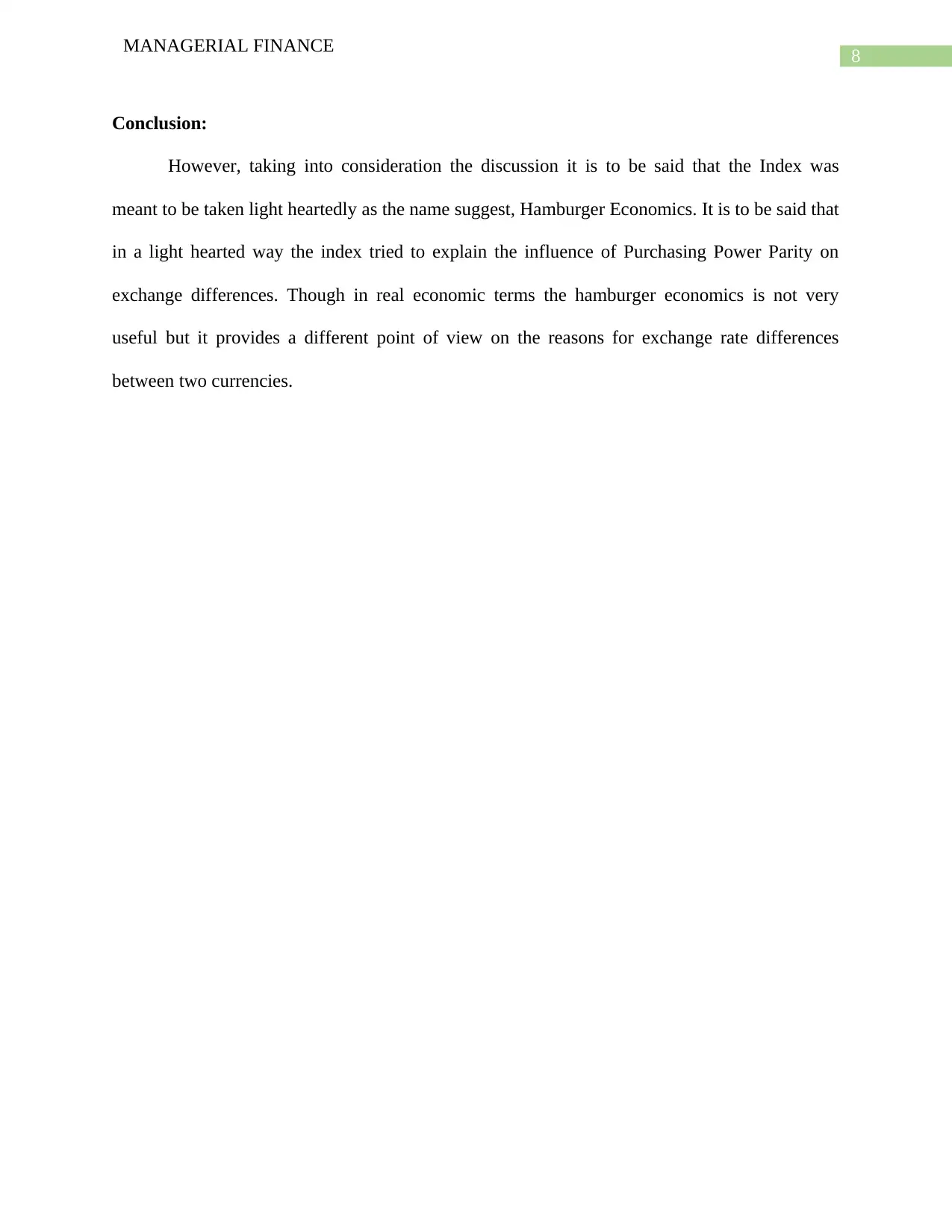
8
MANAGERIAL FINANCE
Conclusion:
However, taking into consideration the discussion it is to be said that the Index was
meant to be taken light heartedly as the name suggest, Hamburger Economics. It is to be said that
in a light hearted way the index tried to explain the influence of Purchasing Power Parity on
exchange differences. Though in real economic terms the hamburger economics is not very
useful but it provides a different point of view on the reasons for exchange rate differences
between two currencies.
MANAGERIAL FINANCE
Conclusion:
However, taking into consideration the discussion it is to be said that the Index was
meant to be taken light heartedly as the name suggest, Hamburger Economics. It is to be said that
in a light hearted way the index tried to explain the influence of Purchasing Power Parity on
exchange differences. Though in real economic terms the hamburger economics is not very
useful but it provides a different point of view on the reasons for exchange rate differences
between two currencies.
⊘ This is a preview!⊘
Do you want full access?
Subscribe today to unlock all pages.

Trusted by 1+ million students worldwide
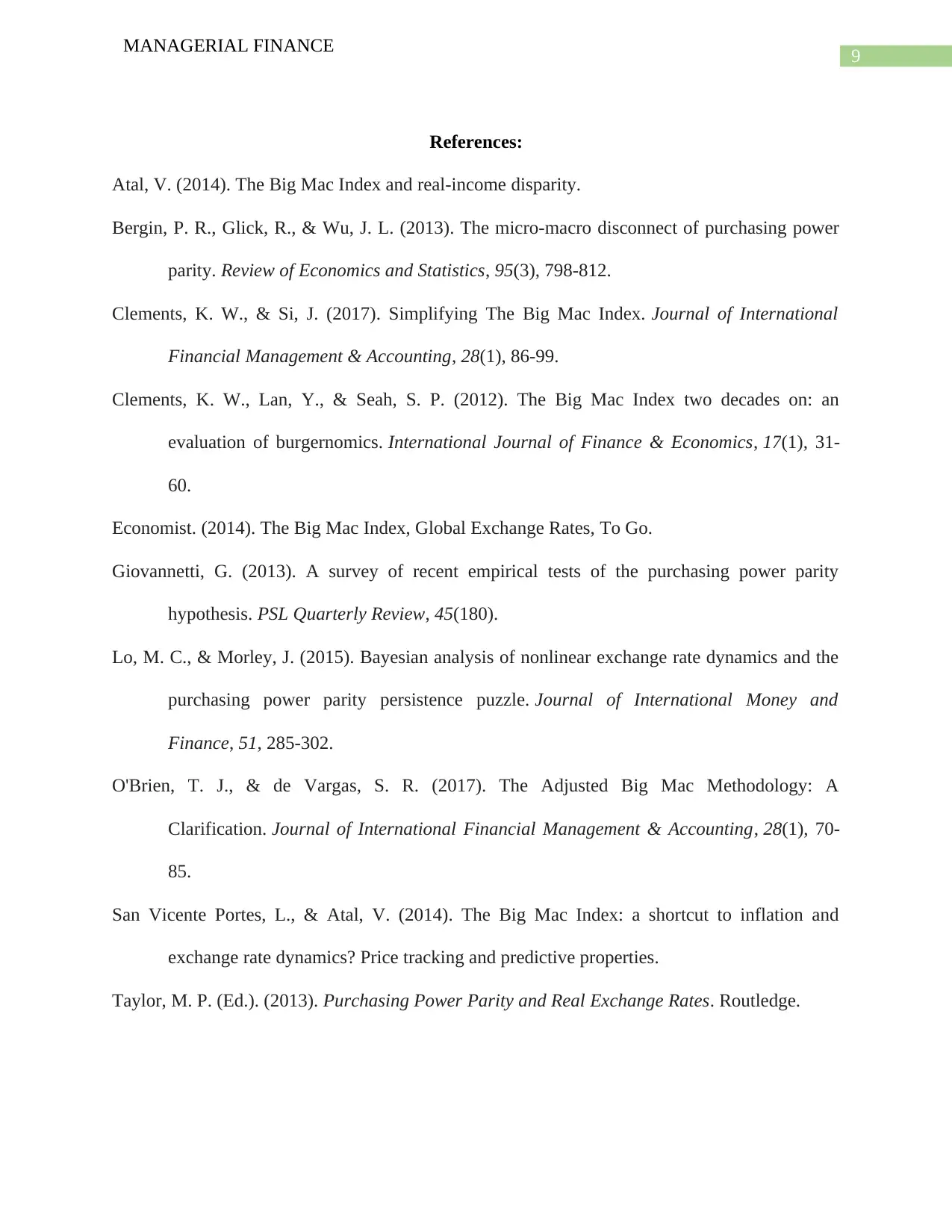
9
MANAGERIAL FINANCE
References:
Atal, V. (2014). The Big Mac Index and real-income disparity.
Bergin, P. R., Glick, R., & Wu, J. L. (2013). The micro-macro disconnect of purchasing power
parity. Review of Economics and Statistics, 95(3), 798-812.
Clements, K. W., & Si, J. (2017). Simplifying The Big Mac Index. Journal of International
Financial Management & Accounting, 28(1), 86-99.
Clements, K. W., Lan, Y., & Seah, S. P. (2012). The Big Mac Index two decades on: an
evaluation of burgernomics. International Journal of Finance & Economics, 17(1), 31-
60.
Economist. (2014). The Big Mac Index, Global Exchange Rates, To Go.
Giovannetti, G. (2013). A survey of recent empirical tests of the purchasing power parity
hypothesis. PSL Quarterly Review, 45(180).
Lo, M. C., & Morley, J. (2015). Bayesian analysis of nonlinear exchange rate dynamics and the
purchasing power parity persistence puzzle. Journal of International Money and
Finance, 51, 285-302.
O'Brien, T. J., & de Vargas, S. R. (2017). The Adjusted Big Mac Methodology: A
Clarification. Journal of International Financial Management & Accounting, 28(1), 70-
85.
San Vicente Portes, L., & Atal, V. (2014). The Big Mac Index: a shortcut to inflation and
exchange rate dynamics? Price tracking and predictive properties.
Taylor, M. P. (Ed.). (2013). Purchasing Power Parity and Real Exchange Rates. Routledge.
MANAGERIAL FINANCE
References:
Atal, V. (2014). The Big Mac Index and real-income disparity.
Bergin, P. R., Glick, R., & Wu, J. L. (2013). The micro-macro disconnect of purchasing power
parity. Review of Economics and Statistics, 95(3), 798-812.
Clements, K. W., & Si, J. (2017). Simplifying The Big Mac Index. Journal of International
Financial Management & Accounting, 28(1), 86-99.
Clements, K. W., Lan, Y., & Seah, S. P. (2012). The Big Mac Index two decades on: an
evaluation of burgernomics. International Journal of Finance & Economics, 17(1), 31-
60.
Economist. (2014). The Big Mac Index, Global Exchange Rates, To Go.
Giovannetti, G. (2013). A survey of recent empirical tests of the purchasing power parity
hypothesis. PSL Quarterly Review, 45(180).
Lo, M. C., & Morley, J. (2015). Bayesian analysis of nonlinear exchange rate dynamics and the
purchasing power parity persistence puzzle. Journal of International Money and
Finance, 51, 285-302.
O'Brien, T. J., & de Vargas, S. R. (2017). The Adjusted Big Mac Methodology: A
Clarification. Journal of International Financial Management & Accounting, 28(1), 70-
85.
San Vicente Portes, L., & Atal, V. (2014). The Big Mac Index: a shortcut to inflation and
exchange rate dynamics? Price tracking and predictive properties.
Taylor, M. P. (Ed.). (2013). Purchasing Power Parity and Real Exchange Rates. Routledge.
Paraphrase This Document
Need a fresh take? Get an instant paraphrase of this document with our AI Paraphraser

10
MANAGERIAL FINANCE
Tate, W. L., Ellram, L. M., Schoenherr, T., & Petersen, K. J. (2014). Global competitive
conditions driving the manufacturing location decision. Business Horizons, 57(3), 381-
390.
MANAGERIAL FINANCE
Tate, W. L., Ellram, L. M., Schoenherr, T., & Petersen, K. J. (2014). Global competitive
conditions driving the manufacturing location decision. Business Horizons, 57(3), 381-
390.

11
MANAGERIAL FINANCE
MANAGERIAL FINANCE
⊘ This is a preview!⊘
Do you want full access?
Subscribe today to unlock all pages.

Trusted by 1+ million students worldwide
1 out of 12
Related Documents
Your All-in-One AI-Powered Toolkit for Academic Success.
+13062052269
info@desklib.com
Available 24*7 on WhatsApp / Email
![[object Object]](/_next/static/media/star-bottom.7253800d.svg)
Unlock your academic potential
© 2024 | Zucol Services PVT LTD | All rights reserved.





